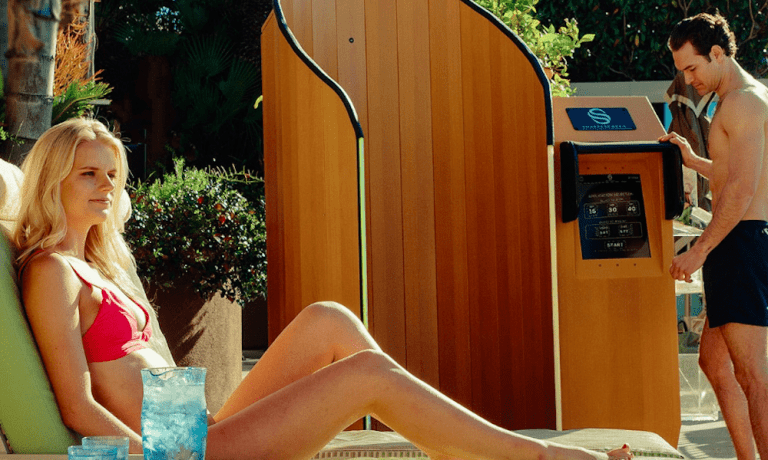No one in the history of mankind has ever enjoyed a sunburn — they’re hot and uncomfortable, they make one’s skin feel two or three sizes too small and, over time, they can even kill you. About 20 percent of Americans will be diagnosed with skin cancer in their lifetime, and about 7,000 people will die from it this year.
Sunblock can be an effective answer, if it is regularly applied when one plans to be out in the sun. However, regular application isn’t always so easy, particularly when sitting poolside. The face, arms and legs are easy to hit, but applying sunscreen to the vulnerable back and shoulders requires either double-jointedness, remarkable yoga skills or asking someone to help.
Realizing that none of these solutions were good, then-19-year-old Kristen McClellan came up with a solution: the SnappyScreen self-service sunscreen spray booth, which advertises the ability to spray down a customer from head to toe in a mess-free layer of sunscreen in just 10 seconds.
In addition to protecting users from the sun, noted McClellan, SnappyScreen’s CEO and founder, the booths are an effective way for hoteliers to drive the incremental spend from consumers sitting poolside, who can do more eating and drinking because they are less worried about getting burnt.
“Rosewood Las Ventanas [al Paraíso] in [Los Cabos, Mexico] recently had [its] first SnappyScreen Instagram post, and [it] had over 25,000 people view it in under 24 hours,” she said. “It has a huge Instagrammable nature — people really think of it as more of an experience than a pure amenity.”
While, today, it is mostly focused on luxury 4- and 5-star hotels and beach resorts, as the self-service sunscreen booths are gaining an increasingly public profile, the company is considering its next expansion.
Advertisement: Scroll to Continue
A Service That Drives Spend
To use the tech, a guest steps into the booth and uses a touchscreen to choose their desired SPF of 15, 30 or 40. The guest stands on a pedestal inside the wood-lined booth, and is slowly rotated while being gently spritzed with SnappyScreen’s proprietary sunscreen formula.
The product is designed to be easily tied to a guest’s room key, so they can charge the $5 spraydown service to their hotel bill. However, most hotel clients aren’t looking at the SnappyScreen device as a revenue creator, but as a revenue driver.
“Most of our clients offer the service as a complimentary perk to their guests, and they do not pay for it themselves at the device,” McClellan said. “What they see is that guests stay longer by the pool, which leads to increased revenue in food and beverage spend, as well as an increase in spa treatments.”
As a result, the company’s clients make more revenue — about $26 extra per day. Yet, perhaps more importantly, McClellan noted, it is a somewhat unusual amenity that breeds goodwill among guests. In a world where consumers largely book online, that extra Instagrammable experience might make the difference between a customer taking the time to write a positive review of the hotel versus saying nothing at all.
Even if they don’t leave reviews, the brand’s tendency to draw Instagram appearances serves as a powerful marketing tool for the hotels with which SnappyScreen has partnered.
“They love taking videos to put into their stories, which has definitely boosted its profile and made people know what it is even before they come to the properties,” McClellan said.
The Broader Market
Though the company’s current target market is luxury lodgings, McClellan noted, it also gets solicitations from a wide variety of venues where an immediate sunblock spraydown would be a useful commodity. These include country clubs, cruise lines, day camps, public parks, public beaches, music festivals — basically, anywhere the sun shines.
SnappyScreen sunblock is designed to be easy on clothing, so fully dressed people on a golf course can use it just as easily as someone in a bathing suit at a booth. That specialized sunscreen spent a year in development — it’s not easy to create a hypoallergenic, water-resistant, reef-safe, quick-drying, continuous-spray formula that is also free of oxybenzone, parabens and alcohol. Whilte the spray booth has earned SnappyScreen recognition, the real revenue driver is the constant orders of the pricey sunscreen.
Five-star beach resorts might be happy to eat the cost of specialty sunscreen to attract more guests, but that probably won’t be the case for public beaches and parks. That means as SnappyScreen grows up and out, it will have to expand the device’s features. Payments expansion is one of them, noted McClellan — particularly mobile payments. A beach-goer with no easily accessible wallet will want to pay using their smartphone, for instance.
The company has also been looking at how to expand the use of the touchscreen in the booth itself. “Something that is growing right now among our clients is using our digital touchscreen space for outdoor digital advertisements,” McClellan pointed out. “That has become a more integral part of the business.”
The experience in a SnappyScreen is just 10 seconds, but, in that time, there is an awful lot that can be shown to a customer. A hotel location might want to roll out other amenities and services that the poolside guest can enjoy, while at a music festival, it might be useful to push concertgoers toward vendors.
“The digital advertising space has been a growing component that I could definitely see us introducing very soon,” McClellan said.




